-
Posts
2,284 -
Joined
-
Last visited
-
Days Won
6
Content Type
Profiles
Forums
Blogs
Gallery
Events
Store
Posts posted by PKeating
-
-
Very nice! It's actually the transitional type and even rarer than the normal Type 1 "extended talon" badge. It has period repairs, which is fine. The flaw in the area of the diving eagle's talons was caused by a cack-handed attempt to revise the die because of the fragility of the talons. There is another one of these transitional types with the "beard" under the Wehrmacht eagle's beak, as the die-flashing left in place on the Type 2 badges is sometimes called by collectors. This example has the flashing filed away, which was another finishing operation that often ended in breakage of the eagle's head.
I know Nick & Co shan't mind if I direct you to a short article I wrote on the Army Parachutists' Badges, which can be seen at http://www.militariacollecting.com/index.php?showtopic=21567. It should explain in more detail what you have there and why it is really rather special!

Here's one of mine, engraved to Obergefreiter Sell, who was amongst the first 170 or so members of the Fallshirm-Infanterie-Kompanie to receive the new Heer badge in September 1937. He had this badge engraved by C E Juncker in the style of the private purchase 800 silver badges after June 1938, when the FIK had become the Fallschirm-Infanterie-Bataillon. Sell was with 2./Fallschirm-Infanterie-Btl. The fragile aluminium hook broke, probably when the Wehrmacht eagle's head received that slight dink, presumably when it was dropped, and the badge was clearly not worn again after that, otherwise it would have been repaired like so many of the originals worn by former FIK/FIB men throughout WW2.

Here's Rudolf Witzig wearing his Type 1 badge in 1943, sometime after the distribution of Kreta cuff titles. But thanks for sharing your rare variant. It's a really nice badge. It is surprising that C E Juncker let these out of the door but I know of just three transitional aluminium and one silver FSA (Heer) (Ludwig Eger's badge). Juncker then produced entirely new diving eagle dies but continued to use the same dies for the wreaths.
PK
0 -
I don't know how much it is worth but it is a really nice grouping from a veteran's estate. I've sent you a PM.
PK
0 -
I believe they're all original and the repair appears to be period. As John says, it's nicely done. They were indeed quite fragile, due to the holes adjacent to the wreath, and tombak and zinc clasps often cracked at one or more of these points, especially if the wearer applied pressure to the badge and/or the pin in an attempt to bend one or both to induce more pressure between the pin and the hook, lessening the risk of losing the clasp. The holes were a silly idea for obvious reasons but do you think they were initially intended for the suspension of hangers by hooks and chains, before the soldered eyelet system was adopted?
PK
0 -
Some of you are doubtless familiar with the 1937 book by Leni Riefenstahl featuring stills from her film. The images are actual prints from the film, with the exception of the photographs in the back of Riefenstahl and her team at work.
I took a couple of copies to be signed by Riefenstahl. She signed one of them with a nice dedication but when she saw this copy, she became quite angry, explaining to me that "that bastard Goebbels" had done all in his power to sabotage her film yet had had the brassnecked cheek to acquire a couple of palettes of the book and send them out as Christmas gifts with a page inserted bearing his signature and a Christmas greeting, as if he had actually had been involved in the production of the film.
She was so furious at the memory of this episode that she refused to sign it, sixty-five years later, unless the offending page was ripped out. Well, I had one signed copy and another with a great story epitomising Goebbels' general modus operandi and amorality attached to it so it remained intact.
PK



 0
0 -
I don't know whose photos these are. Someone sent them to me years ago. But it's interesting to see the 2nd Class cross on an Austrian riband. I have seen several like this over the years.
PK
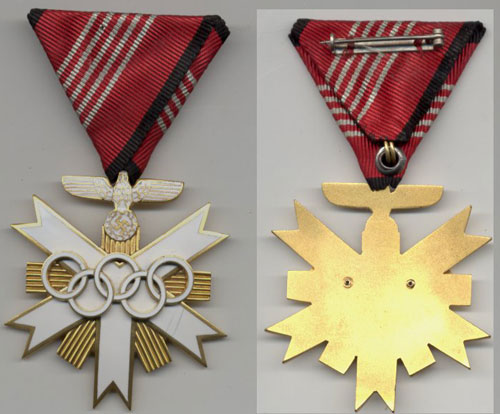
 0
0 -
Back to Olympics awards and whathaveyou. Here, on the right, is a non-portable award for members of international youth clubs, like the Boy Scouts, who helped at the games. It's quite a rare piece in itself. On the left is a studio prototype of the award, cast in bronze by H Noack of Berlin but designed and produced by Otto Plascek, whose name will be familiar to anyone who has one of the combat badges designed by Herr Plascek during WW2, like the Kriegsmarine Minesweeper and Submarine Hunter Badge.
Interestingly, the prototype bears no swastika, in line with the initial directive from Hitler's office that the games should be completely free of political overtones because of sensitivity about the protests abroad against the hosting of the games by Nazi Germany yet the final version does bear a swastika, Goebbels, presumably, having prevailed on this point.
As a sidenote, the infamous incident when Hitler is supposed to have refused to shake hands with the African-American athlete Jesse Owens was not quite as reported by many sources. Up to that point in the games, Hitler would mount the podium to congratulate winners and runners-up and the event won by Owens was no exception. However, the IOC representatives made it known to Hitler precisely at this point that it was not really form for the national leader to do this because of the non-political, international nature of the games. So Hitler left the podium quite quickly but Owens reportedly said later that the F?hrer had come to him and the others just afterwards, behind the podium, and congratulated them on their performance.
However, Owens' account did not quite fit in with the approved view of Hitler as the sort of raving, boneheaded racist who would publicly snub an American guest of Germany, black or otherwise. Whatever he may have thought of blacks and of Owens' victory, Hitler was too canny an operator to get caught out like that. On the occasions when Hitler met Max Schmeling, for instance, he was always unfailingly courteous to Schmeling's American-Jewish manager, Joe Jacobs, even though Schmeling's refusal to change his agent in the face of Nazi pressure would partly fuel the vicious whispering campaign mounted against the boxer by the various hobgoblins working for the indefatigably nasty Goebbels.
PK



 0
0 -
Here is the Greenland Whale in which von Gronau and his crew flew the Atlantic and then the planet. Note the configuration of the engines. Anyway, this is a digression from the topic of Olympic awards but I thought some of you might like to see his plane.
PK
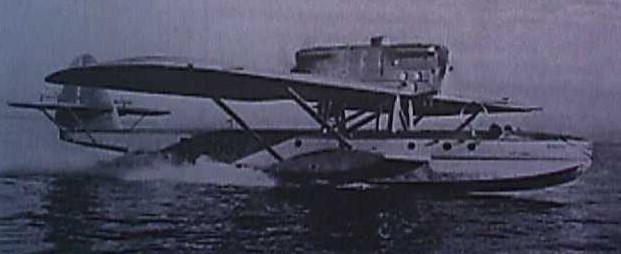
 0
0 -
I am sure a lot of the 1st Class attributions were grace and favour awards but some of the recipients, like the filmmaker Leni Riefenstahl, certainly earned theirs. She still had her various certificates as well as a lot of the workboards pertaining to her Olympia films when I visited her. Eduard Dietl probably earned his as well. I imagine he got it for involvement in the Winter Olympics in Garmisch and Partenkirchen in February 1936.
I believe, although I could be wrong, that another Heer recipient was Hermann Ernst Wilhelm H?lter, who ended the war as a Generalleutnant in Norway. He was a captain in 1936 but served as the primary consultant for army sports training at the Reich War Ministry, and also as a member of the German Olympics Committee for the winter games as well as taking part in the Berlin games in the Military Ski Patrol and Pentathlon events. There again, he could just have received the 2nd Class cross. Perhaps Rick has a list of this officer's decorations?
Below is Luftwaffe recipient Generalmajor Wolfgang von Gronau. I do not know why he received the Olympics award but the photo was certainly taken during the war as von Gronau appears to be wearing the Japanese 2600th National Anniversary Commemorative Medal, which dates the photo to sometime after November 1940. He is also wearing the Order of the Rising Sun, awarded by the Japanese in recognition of his status as Luftwaffe Attach? at the German Embassy in Tokyo from 15.4.1939 to 21.1.1945. So here we have a photo of a recipient wearing the cross long after everyone else appears to have put theirs away.
In the 1930s, Wolfgang von Gronau was one of the pioneers of trans-Atlantic flight, winning the Clifford B. Harmon Trophy in 1932. Currently in the care of the Smithsonian Institute, the trophy was instituted in 1926 as an annual award for the most amazing aeronautical feat of the year. Lindbergh got it in 1927, Balbo in 1928. In 1930, he flew the Atlantic in a seaplane, taking the northern route via Labrador and landing in New York. The 1932 flight for which he won the Harmon Trophy began in Schleswig-Holstein and finished in the Canadian town of Longueuil when he and his crew docked their twin-engined Dornier seaplane, the Wal-Gr?nland or "Greenland Whale", at the Fairchild Aircraft jetty. He then set about trying to establish the quickest route by air between the Europe and the Pacific, effectively circumnavigating the globe and completing 60,000 kilometres by the time he touched down in Rome.
During WW1, von Gronau flew seaplanes off battleships and we can just see the top of his Marine Pilot Badge in this photo. Interestingly, his Knight?s Cross of the Prussian Royal Hohenzollern House Order is the non-military version without swords beneath the crown, which is why it is behind his EK2 and Combattants' Cross of Honour. Unsurprisingly, he was President of the German Aeroclub from 1934 to 1938 and also Vice-President of the International Aeronautical Federation. After Japan's capitulation, von Gronau spent a couple of years in American captivity. He died in 1977.
Ah...an epoque of men against the elements, the harsh rasp of 700 hp aero engines, the smell of hot castor oil and avgas and the distinct prospect of a lonely death in the middle of nowhere. Men like von Gronau tempted the whim of the Gods and lived but many disappeared trying to fly the oceans and the deserts. I often think of them as I peer though an airliner window on moonlit nights 26,000 feet above the Atlantic, surrounded by business executives who take it all for granted...
PK
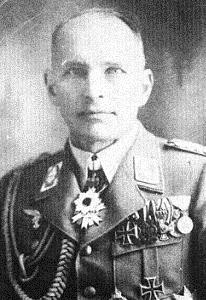
 0
0 -
Here's General Dietl wearing his 1st Class award, along with a couple of mine.
PK
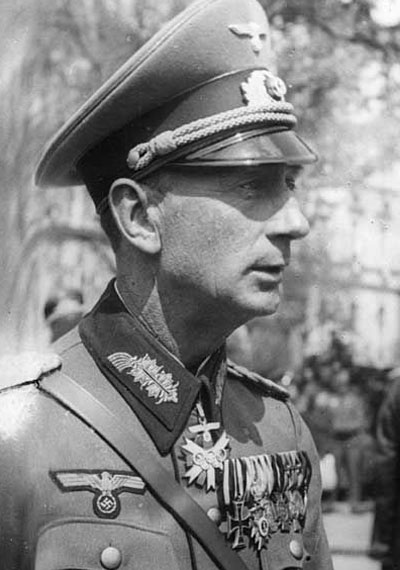
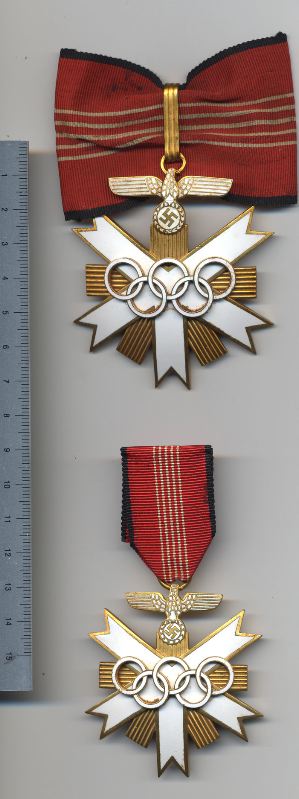

 0
0 -
I spent some time with 271. Fallschirmj?ger and they were a fine bunch of lads with real ?sprit de corps. The run-of-the-mill national service soldiers were rather like conscripts anywhere: the best of them were on a level with a TA battalion of The Queen's Last Resorts and the worst evoked visions of a depot full of sickies excused boots. I remember seeing one BW infantryman - I use that term loosely - in sneakers and a hairnet, with visible rust on his G3. But hey, he'd have done just fine jamming up the runners of T72s had Ivan ever rolled across the border. National Service is a good idea but ought to be for a minimum period of two years. It shan't happen in Europe anytime soon because our rulers fear the notion of citizen soldiers with the military training that might enable the people to overthrow governments by force of arms in the absence of any meaningful say in who is running the show. Politics aside, on a more mundane level, national service would certainly remove a lot of the little hoodies and cornerboys from our streets for a while, which would reduce the noise levels and generally improve everyone's quality of life. It might even help some of them towards evolving into members of the species homo sapiens.
PK
0 -
The ribbon or riband is an integral part of any medal issued with one but I disapprove of the practice of putting a mint riband through the ring of a mint medal that comes in a case or a packet. Call me precious or anal if you like but such an ensemble should surely be displayed as is.
PK
0 -
Correction: the vendor isn't breaking up the group but the estimate is ?13.500,00, which is a lot but which is the market price. The Naumann badge and 1940-dated certificate were offered at $10,000.00 a couple of years ago and found a buyer quite quickly, so I gather. I remain curious about the differences between the Naumann and Lechner badges. Are these due to different dies as a result of die breakage?
PK
0 -
If it is, and it seems to be, then someone is breaking up the group. Vandals!
PK
0 -
Here are the Neumann and Lechner badges side by side. The late Bill Stump, who had seriously studied these badges back when the period was more accessible through living witnesses and so on, had this to say about the Lisbon badges:
This badge is a touchy topic. Therefore, I am not going to make any statement other than to give my person opinion. According to the information I have, the 1st type badge was made in real silver, in Portugal, and I have never owner a specimen of this badge. The die was broken after only a few (unknown number) of badges were produced. the 2nd type badge was struck from silvered non-precious metal. The metal was reported as being "new silver" by some sources [PK note - Klietmann]. In any event, it was stamped from thin sheets of metal. Examples of this type badge are like the badge I posted. Prosper Keating also had a similar 2nd type badge. Only 415 Condor Legion panzer badges were bestowed.A close friend and former driver for Oberst von Thoma, then Unteroffizer Ernst Bartz, years later assisted Roger James Bender as an advisor during the research and production of his book, LEGION CONDOR .. UNIFORMS, ORGANIZATIONS AND HISTORY. He furnish hundreds of photographs and answered as many questions about the Panzer troops "Drohne". According to Roger, Bartz verified the type badges used and issued in Spain during the Spanish Civil War.
Now how do we know how many of these 2nd type badge were actually produced? Were other variations produced during the period from 1939 to 1945? I can't answer these questitions and I have yet to hear from anyone else who can. Jorg Nimmergut thinks so and lists a number of variations in his book, DEUTSCHE ORDEN UND EHRENZEICHEN BIS 1945. Uwe Lautenschlager in his magazine article seems to think so.
However, for me, I would not accept any badge other than the 1st type, which I don't know of any today, or the established know 2nd type like I posted, like Prosper once owned, and like Ernst Bartz wore as a Condor Panzer Legionnaire. The rest, unless they come with an iron clad province, would just not be for my collection. Why would I want or anyone want a problematic badge if they could get a badge that is unquestionably the type I am calling the 2nd type?
By "2nd Type", Bill meant the German-made badges actually awarded to Condor Legion tankers in Berlin in 1939 and 1940. A typical minimum production run at the time for any firm tooling up to strike badges and medals was five hundred units. With just 415 recipients of the badge to consider, it seems unlikely that the OKH would have ordered up more than the equivalent of two or perhaps three minimum production runs. Perhaps they just ordered enough for the recipients, hence a firm like Otto Schickle and perhaps one or two others (according to photographic evidence) seeing the chance to make duplicates for retail sale to the recipients.
Regarding the Type 1 badge from Lisbon, it was reported by some sources that the die broke and that a second die had to be made. So this is true, it means that there were in fact Type 1a and Type 1b badges. Now, if you look very closely at the Neumann and Lechner badges, you can see slight differences in the teeth and the bones. The Neumann badge is too worn to afford a really fruitful comparison but the differences are there. So, are we looking at Type 1a and Type 1b badges here, or is there a more sinister explanation? Once the Lisbon die broke, was a second die made by the supplier to fill the order?
PK
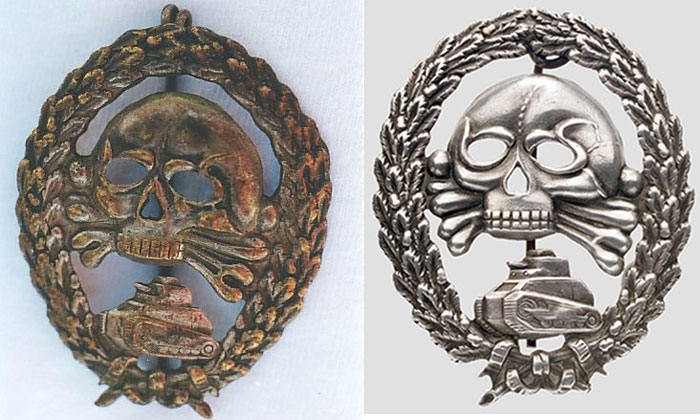
 0
0 -
Reverse:
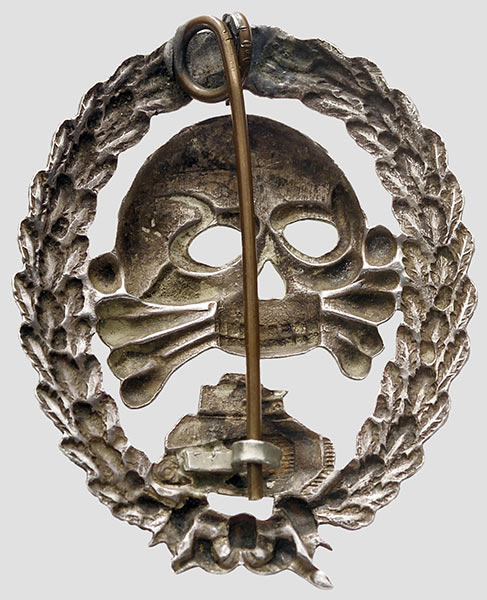
 0
0 -
Lot Nr.900
Feldwebel (Sergeant First Class) Nicolaus Lechner
medals and citations
Tank Badge of the Legion Condor in silver (1st version), hollow stamped. Pin is a contemporary replacement, one of the lower petioles is broken off. Including the certificate for 17 June 1940 with Colonel
This badge has the same kind of pin repair as the Neumann badge but is in much better condition.
PK
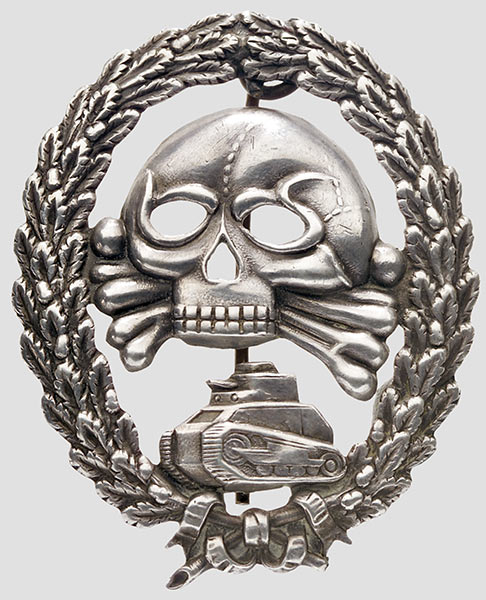
 0
0 -
Maybe. Perhaps the creation of a half-tone photo from a well-made fake is a more credible hypothesis. Just kidding, Brian! Joke! But it is always as well to explore the possibilities and never to underestimate the criminal initiative and imagination where there is money to be made. One can never reproduce a die exactly and cast copies are always detectable because they are smaller than the originals. What better, then, to produce a variant and then produce proof to back it up? The fakers have been doing this with Third Reich stuff since the 'sixties and probably the 'fifties. Some crooks even became 'authors', producing entire books primed with photos of "variants" and "prototypes" of items they had had made and which they punted out to carefully chosen buyers. This was before the internet, of course, and the revolution it brought in the form of exchange of information between collectors. But these issues have been discussed at length in the past. If the half-tone image really dates from 1940, then your badge probably dates from 1940 too.
PK
0 -
How can we be sure of that? Given the intellectual level of the majority of Third Reich militaria collectors - calling to mind George Petersen's immortal remark about "the dirty fingernail brigade" - one doubts if they would understand what they were looking at even if they saw a period reference work. Most of them can hardly get it together to study contemporary reference works. Not that there are many worth studying, of course. Joking aside, you cannot assume that other copies of this catalogue do not exist or have not found their way into the hands of nefarious people. Forgers go to quite amazing lengths sometimes to set up their scams, believe me. I knew some of the best in the business around a quarter of a century ago and I regularly see their products on internet and at shows, and in collections. I mean, if you really want to flirt with paranoia, who's to say that someone didn't make a badge and then fake a catalogue? Easily done, if you know what you're doing.
PK
0 -
Brian,
Thanks for your PM. Having found pictures of your badge on another website, I would say that if the half-tone catalogue photo dates from 1940, then your badge appears to be an absolutely genuine 1940 period example by Otto Schickle. There are some apparent minor differences, like a slight disparity in the angle of the tanks, but given the number of other ways in which the badges appear to be identical, the tank angle difference could be down to photographic distortion. There again, an enterprising faker might have given the 1940 image to a die-cutter who copied the obverse as faithfully as he could but made the inevitable errors of perspective because he was working by hand back in the early 1970s rather than with the laser technology of today...which still isn't perfect. But this is just hypothesis. The badge is probably OK.
PK
0 -
Sorry Brian. I didn't mean to upset you. As I have not actually seen your badge as a whole, I cannot agree that it resembles the badge in the half-tone, retouched image but I don't doubt you. I would like to see obverse and reverse views of it because I am interested in seeing it.
Having a badge for thirty years just means that it has been around since 1975. I really can't see the flaw on the badge in the photograph from the original wartime catalogue posted by Gordon Williamson. All I see are pixels. Perhaps Gordon can scan the relevant bone and post a high res close-up.
PK
0 -
Just to illustrate my last point, look at these three Heer Para Badges by C E Juncker. From left to right, Type 1, Type 2 and Type 3. The wreaths all look a bit different, don't they? Well, they were all struck on the same set of dies, used in 1937/38 and again in 1943/44. They're just finished differently around the edges.
PK

 0
0 -
It is due to hand-finishing, Jacques. The form of the external and internal edges of these badges depends on how much die-flashing was filed off by the person finishing the badge. Collecting Luftwaffe flight badges as you do, you will be familiar with this. The main points to look at are die-struck surface characteristics and details, not filed edges. No two Condor Legion Tank Badges from the same dies have identical external contours. If you look at the retouched catalogue photo, you can actually see the die-flashing between the leaves and the bones. It's heavily pixelated because of the half-tone process but it is there.
PK
0 -
Brian,
Could we see your badge as a whole? There is an apparent die flaw visible in the half-tone picture but the picture has been printed in half-tones and then, I would say, retouched so who is to say that evidence of a die flaw was not added by someone who wished to validate a die flaw on badges that looked like Schickle products? These fakers and forgers are a cunning lot, you know! The image on the catalogue page posted by Gordon seems untouched and is a better photograph than the half-tone one yet I cannot see any traces of the die flaw. It seems strange that traces of a die flaw would be left intact by an art room retoucher, doesn't it? I also can't see any die flaws on the badges posted by Jacques. And nor can I see any traces of any die flaw in the close-up of the Shickle badge in the wartime photo. So, if your badge was struck on the same dies as the badges in the unretouched catalogue photo, the wartime photo and the two studies of badges in collections, then it must postdate all those badges. Gosh! This is like the Steinhauer & L?ck thing, isn't it? I believe Otto Schickle was in business after WW2.
PK
0 -
First I'd seen of the OS supplement. Without seeing the die flaw it would difficult to jump to that conclusion PK as so many of these badges "look alike".
I'm not jumping to conclusions. I am basing my conclusion on a careful comparison between the outline an d other characteristics of the close-up of the badge in the wartime photo and the picture of the badge in the wartime Schickle catalogue posted by Gordon. Look at the bones. Look at the top of the wreath and the outline of the leaves, in particular the leaf that protrudes more than the others. It is possible that they were not struck on the same dies but, IMO, improbable given the peculiarity of the design with that protruding leaf that is a borderline design flaw, rendering the wreath asymetrical. But that is only my opinion, Brian. If your opinion differs from mine, no problem.
PK
0




Heer FJ Badge
in Germany: Third Reich: Wehrmacht Medals, Decorations & Awards
Posted · Edited by PKeating
Don,
The zinc FSA des Heeres is as rare as the prewar Type 2 in aluminium. There were not enough made for all of the para-trained members of: 15. (Fallschirm) Kompanie of the Brandenburg Division; Fallschirm-Btl "Brandenburg" and SS-Fallschirmj?ger-Btl 500. Very few of the SS-Fallschirmj?ger received the Heer badge. Most received the LW version. The majority went to the OKH, which reinstituted the Heer badge on 1.6.1943.
The RFSS obtained their parachute-related kit and equipment from the Luftwaffe, which ran parachute training for the Wehrmacht as a whole. Parachutists' licences also came from OKL. So did the LW pattern Parachutists' Badges in metal and cloth, along with the relevant award certificates.
LW Parachutist's Licence issued to FSA des Heeres holder Walter Scheu through RFSS
The SS-Fallschirmj?ger who received the Heer badges did not receive their A4 FSA des Heeres certifcates until November and December 1944, if they got them at all. The unit had to indent for the documents through SSFHA, which then processed them and sent them back - eventually - to the SS Para Bn for distribution...to those few who were still alive to receive them.
The first two or three SS courses through Fallschirmschule III in Serbia got FSA des Heeres but the small stock obtained by the battalion's training wing was quickly used up. Most if not all of the Brandenburg Para Bn's men got the FSA des Heeres. In short, the majority of the production by C E Juncker was delivered to OKH, which had priority, while the SS Para Bn, formed three months beforehand, only managed to acquire a few. In conclusion, there cannot have been more than three or four production runs of five-hundred units each to equip a company, a battalion and a few members of another battalion. So rest assured that you have something pretty special there!
PK